
Wine Culture and Information since 2002 - Volume 22
 Wine Culture and Information since 2002 - Volume 22 |
|
Issue 14, December 2003 |
Contents |
|
|
A Matter of Cork |
|
In the world of wine it often comes up a discussion which always brings up the same doubts and the same fears, it stays on for some months, producing vivid debates with plenty of victims, wounded and winners, then it is forgotten for some time and, punctually, it comes up again to upset the minds of wine lovers and producers. Anyhow the problem is serious and certainly requires attention: corks used for sealing wine bottles have become in the last ten years a disturbing and painful subject. We all like the romantic and traditional image of the cork we usually find on bottle's necks, the pompous ceremony of its opening always attracts the attention and the respect of the ones who are going to enjoy the content of the bottle, but when the cork is “tainted”, in a second the magic of the moment is vanished and replaced by true disappointment. Let's admit this, we are usually convinced a bottle sealed with a cork contains a better wine, that small cylinder of cork seems to promise an excellent wine, one of those “important” ones. Nevertheless quality does exist for corks as well, there are high quality corks and corks having very low quality. Perhaps the sight of a block of compact and tidy cork is the promising sign of an expensive and refined product, therefore better. Sure, it is just a matter of culture, our culture, that accustomed us to see “the good wine” contained in bottles sealed with corks, therefore the presence of a cork made of a different material disappoints this principle of quality. However anyone who knows wine sufficiently knows cork conceals a feared snare which is revealed only after the bottle has been opened: the possibility of the development of tricloroanisole, a chemical compound also known as 2,4,6-tricloroanisole and abbreviated as 246-TCA, that is the main responsible for the so called “corky smell”.
Cork is an extraordinary material, from a physical and mechanical point of view it is an amazing miracle of nature, to tell the truth, one of the many. Its structure allows it to have remarkable elastic capabilities, even when subjected to strong compressions it is capable of restoring its original shape. Moreover it also has excellent hermetical qualities, in particular for liquids, and its structure allows it to “breathe” by the passage of tiny but precious quantities of oxygen from one side to another: its indisputable qualities are certainly useful for the keeping, aging and the refinement of wine contained in a bottle. There is still the inconvenient corky smell to disturb the scene, a fact that, according to recent figures, affects about 3-5% of the total world production of wine. If we consider that, it is not something to take lightly, it represents an economic loss for producers which is not negligible. Moreover it should be considered that not very expert wine consumers, not being able to recognize the corky smell, could misunderstand this defect as a sign of a low quality wine therefore having prejudices on the wine itself and on its producer. Since many years they are studying new alternative solutions to this problem and in particular they have been introduced on the market synthetic corks, produced with many chemical compounds, and that have good elastic qualities, just like natural cork, and ensure an absolute hermetic quality. In other words, whether natural cork allows the passage of a tiny quantity of oxygen to the inside of the bottle, an useful characteristic for the aging of some wines, synthetic cork does not guarantee the same function. Probably this is not the main problem connected to these corks, what limits the spreading of this solution is the prejudice of consumers, in other words, synthetic cork is not believed to have the same dignity of natural cork and it is often believed to be used for low quality wines. As a matter of fact many producers are already using synthetic corks in many quality wines, therefore, the prejudice connected to a lower quality of the product does not have any concrete reason. Let's admit that, the scarce acceptability of synthetic corks is simply prejudicial: we are still tied to the idea about associating quality wine to natural corks while forgetting that what we appreciate the most in our glasses is wine, not the cork nor the label. Does this seem to be a war in favor of synthetic cork and against natural cork? Absolutely not. Indeed, this is a war in favor of common sense. Natural cork offers indisputable advantages when compared to synthetic cork, thanks to its capacity of allowing the passage of oxygen ensure a better aging of the wine kept in the bottle, whereas synthetic cork, which offers a higher hermetic quality, does not allow any passage of oxygen. Researches done on the development of wine contained in bottles sealed with synthetic corks, have discovered that after about 18 months the organoleptic qualities of wine deteriorate, in other words, after two years, it seems, wine is not in good conditions anymore. On the other hand natural cork can be cause of the inconvenient “corky smell”, whereas synthetic cork does not. One could come up with the conclusion that natural corks are excellent for wines to be aged in bottle, with the risk of corky smell, whereas the synthetic ones are not suited for long aging. If we carefully consider the problem and wines offered by the market, how many of them are truly suited for long aging in bottle? Very few. Most of the wines produced, in particular white wines, have a pretty short “lifetime”, the same is true for many reds as well, usually believed to be suited for aging in bottle, they lose their best qualities after two or three years. We know almost the totality of white wines is to be consumed in their youth, preferably within two years from the time they were released on the market; white wines truly suited for long aging in bottle are few, very few. Red wines suited for long aging in bottle are expressly created by producers for this specific purpose, and they will certainly use natural corks for them. Most of the red wines produced are suited for a rapid consumption and they do not improve with the aging in bottle. Therefore synthetic corks are a good solution for wines not suited for aging and this is the intelligent choice many producers made no natter it is not very accepted by consumers. According to this point of view, this seems to be a guarantee for the integrity of the product while diminishing the risk of spoilage because of corky smell. Honestly, we do prefer seeing in bottles of cheap wines not suited for aging, synthetic corks instead of very bad and scarce natural corks of disputable quality. In wines destined to the aging in bottle, no, in those we expect to see high quality natural corks which ensure the best conditions for their aging. Whether synthetic cork is still a cause for the prejudice in many consumers, we would like to know what they think about another alternative solution which has been adopted by some producers already: screw caps. In case synthetic cork offers some possibilities to the ceremony of the opening of a bottle by using a corkscrew, screw cap does not even need that: a simple movement of the hand and the bottle is opened. Even in this case corky smell does not have any chance to develop and whether the acceptability of synthetic corks among consumers is pretty low, screw cap is even less accepted. Natural corks are expensive, in particular the ones produced from a single block, that is the ones which are suited for keeping and aging wine for a long time. Synthetic corks are cheaper and the prejudice still existing on their acceptability limits their usage and spreading. Maybe this is because of consumers being accustomed and attracted to appearance instead of substance: a bottle having a nice label and a cork promises an excellent wine, nevertheless experience and our senses teach us there are so many bottles with beautiful labels and corks containing wines not really excellent, indeed, truly disappointing.
|
||||||||||||
MailBox |
|
In this column are published our reader's mail. If you have any comment or any
question or just want to express your opinion about wine, send your letters to
our editorial or fill in
the form available at
our site.
|
| I would like to ask you a question about wine's appearance evaluation and in particular about the examination of fluidity or consistence. In your magazine I read the evaluation of tears is not connected to the quantity of glycerol contained in wines, but to the quantity of alcohol and in particular to the effect of surface tension. It could be asserted the higher the quantity of alcohol contained in wine the higher the number of tears? Does the speed at which tears flows down have a specific meaning? Does Glycerol have any connection to the phenomenon? Moreover, the simple observation of tears could be risky and could be cause of prejudices in the organoleptic evaluation of a wine? In the hope of receiving an answer from you, I am sending my best regards. |
| Claudio Olla -- Cagliari (Italy) |
| Dear Mr. Olla, the evaluation of wine's consistency and fluidity exclusively based on the so called phenomenon of tears, is a practice which is less and less used and considered by tasters. The presence of this phenomenon is regulated by many physical and mechanical factors and they could also compromise the reliability of the examination, as you rightly observed. For example, if we consider the state of cleanness of a glass, and in particular the soap used for its washing, they highly modify the fluency of the sides and therefore compromise the reliability of the examination done by the simple evaluation of tears. This examination is virtually ignored by the ones who taste wine professionally and it is not used for the determination of its organoleptic qualities just because it is affected by many factors, the components of wine themselves, besides glycerol and alcohol, as well as the condition of glass, which make this evaluation not really reliable. In recent times this examination was considered by many tasters, and there are still many convinced about that, as an indisputable sign of the quality of a wine, they believed the presence of tears would show “the fat of wine” and therefore its body structure, in particular the quantity of glycerol. Indeed the phenomenon of tears is produced by many physical events, known as “Marangoni effect”, in which play a fundamental role the surface tension, the effect of capillarity as well as the volatility of liquids, in particular of alcohol. |
| Dear DiWineTaste, I would like to send you my congratulations for the magazine and I would like you to give me an advice for a 30 years old wine lover who recently got into the wine world. Where is it best to buy bottles of wine, in wine shops or in supermarkets? Moreover, after having tried some, would you suggest to buy more expensive wines? Would you suggest to attend to a tasting course? I read a lot but I do not have much practice. Thank you in advance. Best regards. |
| Bruno Bonelli -- Salerno (Italy) |
| Dear Mr. Bonelli, the possibilities on where wines can be bought are virtually endless. Even supermarkets, which not so long ago used to offer modest and disputable wines, are paying more attention on this product and are also dedicating whole sections to wine. It is not uncommon to find in supermarkets wines that many would have thought buying in specialized shops: nowadays supermarkets can offer “great wines” as well. The main problem is not the place where wines are being bought, indeed the seriousness and the way they are kept in the shelves and in stores, is a critical condition for both wine shops and supermarkets, therefore the reliability and care of the manager of the shop is fundamental. The knowledge about the world of wine, fortunately, it is not made of theory only but also by practice and in particular, the willingness and curiosity of discovering new things, represent a fundamental factor in order to improve one's capacities and culture. On this regard it is certainly advisable to attend to a serious tasting and wine's organoleptic evaluation course. However it should be remembered what it is taught in courses is to be considered as a first step, certainly fundamental and precious, and alone it does not take to any useful result in case it is not supported by a profitable practice done seriously after the end of the lessons. Tasting as many types of wine as possible, whether coarse or valuable, is a precious practice for every taster and for every wine lover. However it should be remembered tasting does not mean drinking, even worse, in a distracted and uncaring way; the culture of wine and its real appreciation are based on moderation and not in the abuse, a simple principle known to every wine lover who calls himself or herself like that. |
GreeceThe Hellenic country, father of western and modern civilization, had the merit of spreading the culture of wine in Europe and after its glorious past, obscured in the past few centuries, Greek enology is getting back to an interesting wine production |
|
When talking about Greek wine, it is virtually impossible not to mention its glorious history and its fundamental contribution to the spreading in Europe of the beverage of Bacchus, but as we are talking about Greece, it would be more appropriate to say “the beverage of Dionysus”. In ancient times Greek wines, in particular sweet wines, were renowned everywhere, above all in ancient Rome, and Greek settlers introduced the vine and the cult of wine in the lands and in the places where they set their foot. From those places the spreading has been wide and quick, even though many centuries have passed, the results are still alive and well established in the cultures of the European countries. Despite the importance of wine in the culture of ancient Greece, a factor that would make one think about a development of the country like no other country in the world, the production of wine in Greece has faced in the past centuries a long period of recession. Whereas in other European countries they continued the development of enological techniques, Greece did not do the same, in particular during the domination of Ottomans, and the extraordinary fame of Greek wine was consigned to the memory of time. In pretty recent times, in particular in the last twenty years of the last century, Greek enology is showing new life trying to recover and to keep up with the other wine producing countries of the world.
History of wine in Greece is certainly among the richest and this beverage played an important and fundamental role from the first periods of the establishment and development of this civilization. The production of wine at those time was already known to be made by other people, such as ancient Babylonians in Mesopotamia and Egyptians, who preferred beer, whereas it was in ancient Greece wine acquired an important role and from there it spread in all the Mediterranean area. Greeks developed from the very beginning efficient viticulture techniques and they were also introduced in the countries they colonized, such as south Italy, while favoring the cultivation of vine and the production of wine up to making them be integral parts of the cultures and rites of the people in the Mediterranean. For Greeks wine was a sacred beverage to which they attributed very high importance and dignity: archaeological findings older than Mycenaean culture, dated back before 1600 B.C., proved at those times wine was already a beverage used for ritual and religious purposes. Greek mythology had a god of wine, Dionysus, who revealed to men the secrets of the production of the beverage, the initiation to the cult of this god included drinking wine and in his honor were celebrated the so called “Dionysiac orgies”, real and proper wine festivals. It is more likely wine drunk in ancient Greece was not only the one produced in the country; some archaeological findings, in particular vases found at Mycenae not belonging to the Greek art or custom, suggest at those times wine was also imported from other countries. During the classical period vine was widely spread in all the country and Greeks introduced their species in the countries they colonized, in particular Italy, where some species which are believed to have a direct Greek derivation are still common. As wine was an essential part of Greek cooking and culture, the beverage become an essential element in the countries where Greeks spread their cultural influence. Even wine trading represented an important aspect for Greece. Archaeological findings discovered in the many countries of the Mediterranean, but also in the countries of the Middle East, prove wine represented a very important good for the economy of the country and it was a precious good of exchange. Greeks greatly contributed to viticulture and enology: since the times of ancient Greece there were many books with precise mentions about the cultivation of vine and enological techniques. Even the decorations found on the rich patrimony of vases and cups of ancient time prove with their pictures the many scenes of harvests and techniques adopted for the production of wine. The frequency of literary citations and artistic pictures is so high that makes think of wine as an almost central element in the life and culture of the people of those times. Wine was an essential part of one of the most important social events in ancient Greece, symposium (literally “drinking together”), which took place is a room hosting from seven to eleven people laying on couches and who were served wine. Symposia, considered as unseemly for women who usually did not take part to them, spread in Italy as well and their popularity remained intact until the end of ancient age. Wine served during the symposium usually followed a real and proper meal and it was diluted with water: the one in charge for the delicate duty of dilution was the symposiarch, the master of ceremony, who also had the responsibility of regulating the course of the event and the moments in which drinking wine and the quantity. The purpose of symposia was to make a pleasing occasion in which wine should contribute to the pleasingness of the event, however it was not uncommon that participants got drunk as a consequence of competitions and challenges about the resistance and the capacity to drinking. The wine produced in ancient Greece was very different from the one we are used to appreciate today. Greek wines were usually considered for their color, just like today, and they were classified as white, black or red, and mahogany. It seems Greeks paid particular attention on wine's aromas which were usually defined as “flowery”, however in the literature of that time, some wines are also described in a more detailed way and explicitly referring to particular flowers, such as violet and rose. The taste of wine, or better to say, the taste preferred in wine at those time was sweet, even very sweet, and it was very common to make wine by using dried grapes. Sweet wines were very appreciated in ancient Greece and often the sweetness was concentrated by boiling wine in the aim of reducing the quantity of water. Nevertheless sweet wines were not the only ones to be produced in ancient Greece. There are evidences suggesting wines were also produced with underripe grapes and with a very high acidity that they could also make the eyes water, as well as dry wines, both white and red, therefore confirming the Greek enology was very varied. The main problem of the wines of those times was the scarce preservability because of the containers and mainly because of their scarce capacity to be airtight. Wines got oxidized quickly and Greeks were forced to adopt measures that could ensure a better preservability of wine. The adding of pine resin in the wine represented one of those remedies, and this is still used today in one of the most renowned product of Greece, Retsina, as they believed this component had some preserving capabilities. During the medieval age the production of wine was mainly made by privates and by monasteries, just like in the rest of Europe. After the glorious past of ancient Greece, the country become part of the Byzantine empire and therefore the main trading center for Greek wine become Constantinople where were mainly traded wines from all the islands of the Aegean sea. The local production of wine underwent a strong recession when emperor Alexius I Comnenus, in 1082, granted the possibility to Venetians the establishment of trading facilities in Constantinople, as well as in other 32 cities of the empire, with total exemption to the payment of any tax. Thanks to this fiscal benefits Venetians could sell their wine at lower prices: an advantage which stayed in force until the half of the fourteenth century. The flourishing wine trading in the Byzantine empire ceased at the end of the fifteenth century, after the end of the Byzantine empire, when Turks occupied the Peloponnese and spread their domination all over the Greek peninsula. During the domination of Ottomans, Greek enology underwent another recession which compromised its development until the end of the dominion. Despite the fact the production of wine was not forbidden to Christians, the enological industry was severely oppressed by taxes imposed by Turks and diminished the production of wine as well as limiting both the spreading and development. The awaking of Greek enology can be considered from the beginning of the 1900's, when the country finally reconquered its independence. However the real interest for the development of local enology arose only after the end of World War Two, no matter most of the wine produced was considered as having low quality and sold non bottled. In the last 20 years Greece is paying more and more attention to the qualitative development of its wine, also conscious of its glorious past, and the enology in the country is progressively improving also thanks to the adoption of modern technologies and competent wine makers.
|
||||||||||||
|
The quality system for Greek wines is regulated by specific laws emanated by the Ministry of Agriculture in 1971, however the system currently in force is the result of a revision done in 1981 as a consequence of the joining of the country to the European Economic Community. The current system is based, in general terms, on French's Appellation d'Origine Contrôlée and are recognized specific wine regions, permitted grape species, cultivation procedures and wine making practices as well as norms regulating the labelling of bottles. The system recognizes three different categories as follows:
|
|
The current wine production in Greece is mainly made in the same regions that made Greek wines famous in ancient times. The soil of Greece is particularly suited for the culture of vine, a characteristic which was well known to the ancient inhabitants of the country. In Greece are mainly cultivated local grapes, it is said there are about 300 different species of them, as well as “international” grapes which represent a minimal part and are usually blended with the local ones. Among local white berried grapes there are Assyrtiko, Moscophilero, Muscat Blanc, Robola, Roditis and Savatiano, the grape mainly used for the production of the renowned Retsina. Among local red berried grapes there are Agiorgitiko, Kotsifali, Limnio, Mandelari, Mavrodaphne, Negoska, Stavroto, Krassato and Xynomavro. The production is made of about 75-80% of white wines, about 15% is represented by red wines and the remaining part is about sweet wines. The most important white berried grapes are Assyrtiko and Savatiano, besides being used for the production of Retsina it is also the most common grape of the country. Among white berried grapes there is also Robola, by many considered as the typical Ribolla from Friuli Venezia Giula and it seems it was introduced in the country by Venetians in the thirteenth century. The most important red berried grapes are Mavrodaphne, Agiorgitiko and Xynomavro. Among the most important wine regions of Greece are to be mentioned Macedonia, Thessaly, Peloponnese, Aegean islands and Crete island. In these regions are probably produced the most renowned wines of the country and are the ones which historically associated Greece to wine. In the northern area of the country there is Macedonia which includes two important wine districts: Naoussa e Goumenissa. Naoussa, among the most renowned areas of all Greece, is famous for its red wines produced with Xynomavro grapes, full bodied and structured, whereas in Goumenissa the same grape is blended with Negoska grape therefore producing less bodied wines. In the region of Thessaly, in the central part of Greek peninsula, there is the area of Rapsani where are produced red wines, near the Olympus mountain, with Xynomavro, Stavroto and Krassato grapes. In the Peloponnese, in the southern part of the country, there are three important wine areas: Nemea, Mantinia and Patras. Nemea's wines are mainly produced with Agiorgitiko, a very common red berried grape, whereas Mantinia's wines are usually produced with Moscophilero, an aromatic grape having a pink colored skin used for the production of white wines. The most renowned area of Peloponnese is Patras where are produced three different styles of wines, of which only two are of primary interest. The first one of the is the renowned Muscat of Patras, a sweet and aromatic wine produced with Muscat Blanc grape, whereas the second one is a sweet red wine produced with Mavrodaphne grape and aged in cask for a very long time, it is usually fortified and characterized by a slight oxidization comparable to the one of Port Tawny. Among the many Greek islands of the Aegean sea, two of them are renowned for their wines: Santorini and Samos. The typical grape of Santorini is Assyrtiko which used in the island both for the production of dry white wines and for its famous Visánto. This particular wine is produced with dried Assyrtiko grapes and a part of Mandelari grape. Visánto usually ages for about 10 years in cask and develops rich, enchanting and complex aromas. The Samos island is famous for a sweet wine as well, the renowned Muscat of Samos, produced with Muscat Blanc grape and sometimes fortified, characterized by intense and rich aromas of grape and apricot. Among Greek islands must be mentioned Crete, of ancient and noble enological origins, and still today is tied to its local grapes, particularly to Kotsifali and Mandelari, which are used for the production of wines of Archarnes. Among Greek wines must be mentioned the famous Retsina, despite the fact this is to be considered as an aromatized wine instead of a wine in the strictest meaning of the term, it is still the most renowned and spread wine in the country. Retsina, particularly appreciated by locals and real attraction for tourists, has an important position in the wine production of the country and represents 30% of total production. Retsina is currently produced in almost every part of Greece, however the main area of production is Attica, the region where Athens is located. This wine is produced with Savatiano grape and during the fermentation process a small quantity of pine of Aleppo resin is added to the must with the purpose of aromatizing the final product.
|
Recognizing Wine's AromasThe evaluation of wine's aromas is probably the most complex task of sensorial tasting and it takes a good olfactory memory, practice, experience and strategy |
|
The organoleptic and sensorial evaluation of a wine is made of many phases and one the them in particular represents a higher level of difficulty when compared to the others: the olfactory evaluation of aromas. Difficulty of this examination is often because of the scarce attention modern men usually pay to the sense of smell and to the conscious recognition of aromas, and this inattention is usually found in the quality of their foods as well. Smell, besides being an essential factor for taste, is also an indispensable sensorial capacity which helps to guarantee survival as well as to realize dangerous conditions or poisonous foods. The conscious use of the sense of smell is diminished in modern men, frequently distracted by appearance and by what the eyes communicate more explicitly. This diminution is not because of a regression, indeed it is because of the scarce use and inattention as a consequence of the “guaranteed” safe conditions of modern life which probably require a more limited usage, or better to say, a less conscious usage of smell. Most of people who get into wine's sensorial evaluation have the highest difficulties on olfactory analysis, not because their sense of smell is insufficient, but simply because they are not used to recognize aromas in a conscious way and pay little attention to aromas and to smells in general.
|
|
In the organoleptic tasting of wine, the olfactory evaluation has a very high importance, the quality of aromas and their finesse greatly represent its elegance and its class. Moreover, it should be remembered, taste is largely determined by the aromas of foods and beverages, not just by fundamental tastes. Thanks to the recognition of aromas it is possible to determine the nature and quality of a food, thanks to smell it is possible to tell the taste of orange from the one of pineapple. When one has got a cold, it is said not being in the proper condition of recognizing flavors, indeed the capacity of taste buds is not compromised or diminished: the diminished olfactory capacity as well as the congestion of nose greatly limit the recognition of aromas and therefore do not allow a complete and proper determination of taste. Smell is an instinctive sense and allow the evaluation of a food or a condition in very little time and without the conscious evaluation of aromas: in few moments it is capable of communicating the presence of poisonous substances in the air or to signal unpleasing and potentially poisonous foods and beverages, therefore avoiding their ingestion. The task done by the sense of smell is preventive, that is allows the evaluation of a condition in advance in order to avoid negative consequences, but it can also be origin of pleasure in case pleasing aromas are being perceived. The same considerations are also true for the olfactory analysis of wine: it is enough to briefly smell the content of a glass to realize, with good approximation, the quality of wine and the presence of any possible fault. However the olfactory examination of wine does not end after the first and brief evaluation, it requires further attention in order to realize the quality, the recognizability and nature of aromas: factors which also determine the real value of a wine. In fact, a good wine must convince, first of all, the nose. The aromas of a wine and their quality generally have a pretty high importance in every sensorial evaluation system where the value of a wine is determined by means of a score. By analyzing the forms of sensorial evaluation of these system, the portion of score determined by the olfactory examination is usually greater than the others: a proper and clear sign of the importance of the role played by aromas in the determination of the quality and value of a wine. In the olfactory evaluation of a wine done by means of the many organoleptic analysis systems, the examination of aromas is done by individuating the single characteristics on which aromas are expressed and not just by their nature or definition. For example, are evaluated intensity, quality, and therefore the absence of faults, overall finesse of aromas and their harmony, that is the way all the aromas are tied one to each other. Besides to this type of evaluation, olfactory examination also includes the specific individuation of aromas, that is they are described and defined by analogy associating them to known and commonly recognizable aromas, such as aromas of specific fruits or flowers.
The importance of the olfactory examination is also essential for the recognition of possible faults and wine diseases developed during the production process or during aging. The overall perception of aromas, their balance and quality, are usually significative for the next examination, taste evaluation, where the good or bad aromatic premises can also be strengthened by taste. The evaluation of wine's aromas also allows the determination of the typicality and characteristics of the grapes used to make it, moreover, it gives useful information on their ripeness or withering, as well as particular climatic conditions. Finally, the olfactory examination of a wine allows the evaluation of the genuineness of the product and the level of “sophistication”, in other words, the quality of the wine making process and of the grape's cultural practices, whether “extreme” enological techniques were used, with the purpose of covering the low quality of grapes and to hide organoleptic lacks, such as, for example, an exaggerated presence of aromas passed from cask to wine.
|
||||||||
|
Like we said already, the olfactory examination of a wine offers a higher level of difficulty when compared to the other ones, however its importance is high for the determination of the quality and value of a wine. Of course the quality of a wine is not definable only by means of its aromas, certainly the other examinations, appearance and taste, are fundamental as well and allow the appreciation and definition of other important organoleptic aspects. Of the three sensorial examinations, the one requiring a higher experience and practice is however the olfactory evaluation, both for the vastness of aromas that can be virtually perceived, and for the difficulty of isolating and recognizing them. On this regard practice and experience offer a fundamental help, the more the number of wines tasted, the more the aromas encountered, however an important role is also played by olfactory memory, that is the capacity of recognizing and describing an aroma after its perception. The capacity of recognizing aromas is not only based on the number of wines tasted, but also on a good level of curiosity in the evaluation of every smell stimulus, a condition that can happen in every moment of the day and in many situations and this should be a primary characteristic of every good taster. An aroma that was never perceived cannot be recognized or described, in this case it can be perceived and classified as an “unknown” aroma and therefore undefinable. The number of aromas that can be virtually recognized is essential for every taster, however the olfactory examination of a wine has another difficulty which makes the process of recognition of aromas more complex. Let's consider, for example, the aroma of apple, an aroma which is generally known and recognizable by many. Whoever knows this aroma every time he or she is about the smell this fruit, even blindfolded, can easily recognize it. The aroma of apple is pretty frequent in white wines, however the capacity of being able to recognize this aroma is not enough. In a wine every aroma is perceived together with many others and they could also confound them, even cover them, and the capacity of the taster is also of being able to isolate and individuate the aroma of apple, as well as any other aroma, in a context of many aromas. In the olfactory evaluation of a wine there are aromas which are perceived with a higher intensity and are more easily recognizable, whereas others can be perceived only after a careful evaluation and after predominant aromas have been isolated and recognized. This process that could seem complex in the beginning, will be simplified by experience and practice, that is when the task of isolating and recognizing every single aroma will be done “instinctively”. Moreover, the recognition of aromas allows the individuation, in many cases, of the type of grapes used for the production of a wine. There are aromas which are very typical in certain grape species and absent in others, therefore the perception of these aromas can give pretty precise indications about the wine being examined. The typicality of certain aromas in grapes is also determined by many factors which include the area of cultivation, climate and the level of ripeness. If we consider, for example, Cabernet Franc grape, usually characterized by an aroma defined as vegetal, that is comparable to certain essences of plants, the most commonly associated aroma to this grape is the one of green pepper. This aroma is very evident when the grape was harvested when not fully ripe: in fact in Cabernet Franc, as well as in Cabernet Sauvignon, the aroma of green pepper is less evident, sometimes absent, in case the grape was perfectly ripe; in this case there will be aromas of black berried fruits, such as black currant and black cherry, to be predominant. The recognition of typical aromas of grapes is an useful capacity for the taster and it should be properly developed. On this regard can be done proper exercises in order to improve and refine the capacities in the recognition of the many typical grape's aromas and therefore of wine. An useful exercise, in particular for the neophyte taster, it is about individuating and recognizing the difference between an aromatic grape and a non aromatic grape. This exercise can be done by comparing the aromatic differences between a wine produced with Gewürztraminer and one produced with Trebbiano Toscano grape: the predominant characteristic perceived in Gewürztraminer it is what defines a grape as aromatic, that is a strong and clean aroma directly resembling the one of fresh grape. Then it should be compared the wine produced with Gewürztraminer and another produced with Muscat Blanc: despite the fact the two wines have different aromatic nuances, it will be possible to recognize in both the strong and predominant aroma of grape. Both Muscat Blanc and Gewürztraminer are considered aromatic grapes because of this primary characteristic. The same exercise can be done for wines produced with red berried grapes. Let's consider for our examination two wines, one produced with Cabernet Sauvignon and the other produced with Pinot Noir. The aromatic impact of the two wines should be pretty different and distinguishable. Whereas in the wine produced with Cabernet Sauvignon will be found aromas directly resembling black cherry and black currant, in the one produced with Pinot Noir will be perceived aromas of cherry, raspberry and probably strawberry as well. Let's now take a wine produced with Sangiovese grape and let's compare its aroma with the other two wines. In this case the aroma of black cherry, already found in Cabernet Sauvignon, will be perceived, and beside that, an aroma of a flower will be found: violet. The three wines have pretty different aromas and it should be relatively easy to recognize their differences, a capacity that will become more easy with practice and experience. The above example is not to be considered as an absolute reference, it should simply help the neophyte taster to exercise his or her olfactory skills and to develop a good strategy in the recognition of aromas. This means that the aroma of cherry is not an exclusive characteristic of Pinot Noir, it can also be found in Barbera, as well as violet is not an exclusive characteristic of Sangiovese and this aroma is also found, for example, in Nebbiolo grape as well. However the capacity of recognizing typical aromas helps to narrow the number of possible grapes that will be taken into examination for the determination of a wine: in case a clean and strong aroma of violet is being perceived, the possibilities the wine was made with Sangiovese or Nebbiolo grape is pretty high and Pinot Noir, with good certainty, can be excluded. The univocal association between aromas and grapes is not enough for the determination of a specific type. The presence of determined aromas can give hints to the tasters on some grapes, while excluding others, however the recognition of a specific grape must be usually confirmed by other aromas typically present and characteristic in that grape. A good strategy for the recognition of the many aromas is to progressively exclude all the aromas that have been isolated and individuated and then proceeding with the recognition of the others. Another good practice consists in classifying aromas, as soon as they have been perceived, in generic families, such as fruits, flowers or vegetables, and therefore proceeding with a further classification until the specific aroma is identified. This system allows a better and rapid identification of aromas and allows to progressively eliminate classes and categories of aromas until the process of recognition is done. When systematically applied, this method will become with time and practice an almost instinctive and natural strategy.
|
||||
Wines of the Month |
|
|
|
Score legend Prices are to be considered as indicative. Prices may vary according to the country or the shop where wines are bought |
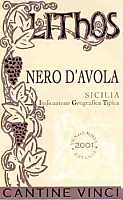
|
|
Lithos Nero d'Avola 2001 |
|
| Vinci Vini (Italy) | |
| Grapes: Nero d'Avola | |
| Price: € 10,20 | Score: |
| The wine shows a brilliant ruby red color and nuances of ruby red, little transparency. The nose reveals intense, clean, pleasing and elegant aromas of black cherry, blueberry, plum and violet followed by pleasing hints of carob, licorice, black pepper and vanilla. In the mouth has good correspondence to the nose, good balance with tannins in good evidence, good body and intense flavors. The finish is persistent with good flavors of plum, black cherry and blueberry. A well made wine. Lithos ages for at least 6 months in barrique followed by at least 2 months in bottle. | |
| Food Match: Broiled meat and barbecue, Roasted meat, Stewed meat with mushrooms, Hard cheese | |
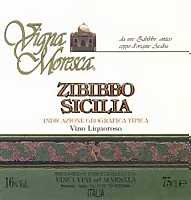
|
|
Zibibbo Vigna Moresca |
|
| Vinci Vini (Italy) | |
| Grapes: Moscato d'Alessandria | |
| Price: € 6,00 | Score: |
| The wine shows an intense straw yellow color and nuances of golden yellow, very transparent. The nose reveals intense, clean, pleasing and refined aromas of raisin, dried apricot, candied fruit, fig jam, almond, orange marmalade and citrus fruit peel followed by a pleasing aroma of caramel. In the mouth has good correspondence to the nose, a slightly alcoholic and round attack however balanced, intense flavors, good body and pleasing sweetness. The finish is persistent with good flavors of raisin and fig jam. This Zibibbo ages in bottle for at least 2 months. | |
| Food Match: Hard and piquant cheese, Confectionery, Dried fruit tarts | |
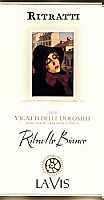
|
|
Ritratto Bianco Vigneti delle Dolomiti 2000 |
|
| La Vis (Italy) | |
| Grapes: Chardonnay, Pinot Gris, Riesling | |
| Price: € 12,00 | Score: |
| This wine shows an intense straw yellow color and nuances of golden yellow, very transparent. The nose reveals intense, clean, elegant and pleasing aromas which start with aromas of banana and toasted wood followed by good aromas of pineapple, hawthorn, acacia, broom, melon, pear and vanilla. In the mouth has good correspondence to the nose, a crisp attack however well balanced, intense flavors and good body. The finish is persistent with flavors of toasted wood, pear and banana. A well made wine. Ritratto Bianco ages for 8 months in barrique followed by 10-12 months in bottle. | |
| Food Match: Roasted fish, Pasta and risotto with fish and mushrooms, Sauteed fish | |
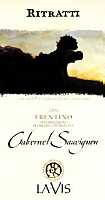
|
|
Trentino Cabernet Sauvignon Ritratti 2000 |
|
| La Vis (Italy) | |
| Grapes: Cabernet Sauvignon | |
| Price: € 9,75 | Score: |
| This wine shows an intense ruby red color and nuances of ruby red, little transparency. The nose reveals intense, clean, pleasing, elegant and refined aromas which start with nuances of black cherry, blueberry and violet followed by good aromas of black currant, plum, licorice, cocoa and vanilla as well as a pleasing hint of thyme. In the mouth has good correspondence to the nose, a slightly tannic attack however well balanced by alcohol, full body and intense flavors. The finish is persistent with good flavors of black cherry, plum and black currant. A well made wine. This Cabernet Sauvignon ages for 14 months in barrique followed by 6 months of aging in bottle. | |
| Food Match: Braised and stewed meat, Game, Roasted meat, Hard cheese | |
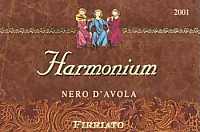
|
|
Harmonium 2001 |
|
| Firriato (Italy) | |
| Grapes: Nero d'Avola | |
| Price: € 18,00 | Score: |
| This wine shows a deep ruby red color and nuances of ruby red, little transparency. The nose reveals good personality and intense, clean, pleasing, elegant and refined aromas which start with aromas of blackberry, black cherry and blueberry followed by carob, cherry, licorice, plum and violet as well as pleasing hints of vanilla, cocoa and menthol with very balanced wood aromas. In the mouth has excellent correspondence to the nose, a slightly tannic attack however well balanced, round, intense flavors, full body and very agreeable. The finish is very persistent with long flavors of blackberry, plum and blueberry. A very well made wine. Harmonium ages in barrique for 10 months. | |
| Food Match: Game, Roasted meat, Braised and stewed meat, Hard cheese | |

|
|
Ribeca 2001 |
|
| Firriato (Italy) | |
| Grapes: Nero d'Avola (60%), Perricone (40%) | |
| Price: € 18,00 | Score: |
| The wine shows a deep ruby red color and nuances of ruby red, little transparency. The nose denotes intense, clean, pleasing, elegant and refined aromas which start with aromas of black cherry, plum and blueberry followed by good aromas of raspberry, licorice and violet as well as pleasing aromas of cocoa, eucalyptus, vanilla and toasted wood. In the mouth has good correspondence to the nose, a tannic attack however balanced, intense flavors, full body. The finish is persistent with good flavors of plum, black cherry and blueberry. A well made wine. Ribeca ages for 9 months in barrique. | |
| Food Match: Game, Roasted meat, Braised and stewed meat, Hard cheese | |
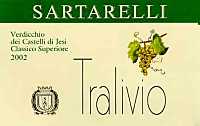
|
|
Verdicchio dei Castelli di Jesi Classico Superiore Tralivio 2002 |
|
| Sartarelli (Italy) | |
| Grapes: Verdicchio | |
| Price: € 7,10 | Score: |
| This wine shows an intense straw yellow color and nuances of golden yellow, very transparent. The nose denotes intense, clean, pleasing and elegant aromas that start with aromas of hawthorn, elder, pear and apple followed by good aromas of pineapple, litchi, peach, grapefruit and almond. In the mouth has good correspondence to the nose, a crisp attack however well balanced by alcohol, good body and intense flavors. The finish is persistent with pleasing flavors of peach, pear and grapefruit. | |
| Food Match: Crustaceans, Fried fish, Sauteed fish, Pasta and risotto with fish, Soft cheese | |
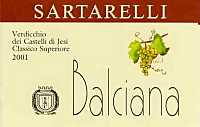
|
|
Verdicchio dei Castelli di Jesi Classico Superiore Balciana 2001 |
|
| Sartarelli (Italy) | |
| Grapes: Verdicchio | |
| Price: € 16,80 | Score: |
| The wine shows a beautiful and intense straw yellow color and nuances of golden yellow, very transparent. The nose reveals personality with intense, clean, pleasing, elegant and refined aromas which start with aromas of honey, hawthorn and apricot followed by good aromas of pineapple, chamomile, quince, hazelnut, pear, peach, grapefruit and almond as well as a pleasing hint of aromas of noble rot. In the mouth has excellent correspondence to the nose, a round and crisp attack however well balanced by alcohol, good body, intense flavors and very agreeable. The finish is very persistent with long flavors of chamomile, pear, honey and almond. A very well made wine. Balciana is produced with late harvest grapes. | |
| Food Match: Pasta and risotto with fish and mushrooms, Roasted fish, Roasted white meat, Cheese | |
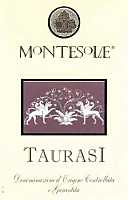
|
|
Taurasi 1997 |
|
| Montesolae - Colli Irpini (Italy) | |
| Grapes: Aglianico | |
| Price: € 14,80 | Score: |
| This wine shows a brilliant ruby red color and nuances of ruby red, moderate transparency. The nose reveals intense, clean, pleasing and elegant aromas which start with aromas of plum jam, black cherry jam and violet followed by good aromas of cherry, carob, blueberry, licorice and vanilla as well as a pleasing hint of leather. In the mouth has good correspondence to the nose, a slightly tannic attack however well balanced by alcohol, good body and intense flavors. The finish is persistent with good flavors of plum, black cherry and blueberry. A well made wine. This Taurasi ages for 8 months in steel tanks, 8 months in barrique, 16 months in cask and for 6 months more in bottle. | |
| Food Match: Game, Stewed and braised meat, Roasted meat, Hard cheese | |
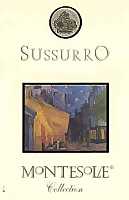
|
|
Sussurro 2002 |
|
| Montesolae - Colli Irpini (Italy) | |
| Grapes: Greco Bianco (50%), Fiano (50%) | |
| Price: € 10,80 | Score: |
| The wine shows a pale straw yellow color and nuances of straw yellow, very transparent. The nose denotes good personality with intense, clean, elegant and pleasing aromas which start with aromas of hawthorn, apple, pear and broom followed by aromas of citrus fruits, pineapple, almond, lemon and peach. In the mouth has good correspondence to the nose, a crisp and slightly round attack however well balanced, intense flavors, good body, agreeable. The finish is persistent with flavors of apple, almond and lemon. Sussurro ages for 4 months in steel tanks and for 3 months in bottle. | |
| Food Match: Pasta and risotto with fish, Vegetable and mushroom soups, Sauteed fish | |
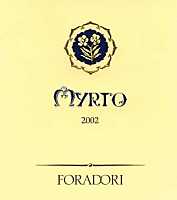
|
|
Myrto 2002 |
|
| Foradori (Italy) | |
| Grapes: Sauvignon Blanc (60%), Incrocio Manzoni (20%), Pinot Blanc (20%) | |
| Price: € 13,50 | Score: |
| This wine shows a brilliant straw yellow color and nuances of golden yellow, very transparent. The nose reveals personality with intense, clean, elegant, pleasing and refined aromas that start with aromas of peach, litchi and passion fruit followed by good aromas of pineapple, banana, broom, apple, pear and vanilla as well as a pleasing hint of elder. In the mouth has good correspondence to the nose, a crisp attack however well balanced, good body, intense flavors and very agreeable. The finish is persistent with good flavors of peach, passion fruit and pineapple. A well made wine. Myrto ferments part in steel tanks and part in barrique. | |
| Food Match: Crustaceans, Pasta and risotto with fish and vegetables, Mushrooms soups, Roasted fish | |
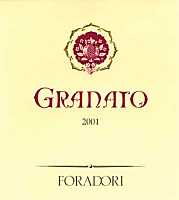
|
|
Granato 2001 |
|
| Foradori (Italy) | |
| Grapes: Teroldego | |
| Price: € 36,00 | Score: |
| This wine shows a deep ruby red color and nuances of purple red, little transparency. The nose reveals personality with intense, clean, pleasing, elegant and refined aromas which start with aromas of black cherry and blueberry followed by good and intense aromas of blackberry, plum and violet as well as pleasing aromas of cocoa, toffee, clove, licorice, black pepper, vanilla, toasted wood and a pleasing hint of rosemary. In the mouth has good correspondence to the nose, a slightly tannic attack however balanced, intense flavors, full body. The finish is persistent with pleasing and good flavors of black cherry, plum and blueberry. A very well made wine. Granato ages for 18 months in cask. | |
| Food Match: Game, Roasted meat, Braised and stewed meat, Hard cheese | |

|
|
Cabernet Sauvignon Vigneto Belvedere 1999 |
|
| Vallarom (Italy) | |
| Grapes: Cabernet Sauvignon | |
| Price: € 14,50 | Score: |
| The wine shows a brilliant ruby red color and nuances of garnet red, moderate transparency. The nose denotes intense, clean, elegant, pleasing and refined aromas that start with aromas of dried violet, black cherry jam and plum jam followed by good aromas of raspberry jam, blueberry, licorice, dried rose and pleasing hints of vanilla, menthol and leather. In the mouth has good correspondence to the nose, a slightly tannic attack however well balanced by alcohol, full body and intense flavors. The finish is persistent with good flavors of plum jam, black cherry jam and blueberry. A well made wine. This Cabernet Sauvignon ages for 12 months in barrique followed by 12-18 months in bottle. | |
| Food Match: Braised and stewed meat, Game, Roasted meat, Hard cheese | |
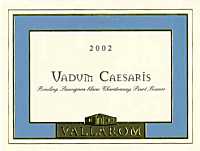
|
|
Vadum Caesaris 2002 |
|
| Vallarom (Italy) | |
| Grapes: Pinot Blanc (50%), Chardonnay (30%), Sauvignon Blanc (10%), Riesling (10%) | |
| Price: € 7,50 | Score: |
| This wine shows a brilliant greenish yellow color and nuances of greenish yellow, very transparent. The nose reveals intense, clean, pleasing and elegant aromas which start with aromas of hawthorn and apple followed by aromas of pineapple, banana, broom, lemon, litchi, almond, pear and grapefruit. In the mouth has good correspondence to the nose, a crisp attack however well balanced by alcohol, intense flavors, good body, agreeable. The finish is persistent with flavors of lemon, apple and pear. Vadum Caesaris ages in steel tanks for 7-8 months and for about 6 months in bottle. | |
| Food Match: Sauteed white meat, Pasta and risotto with fish, Roasted fish | |
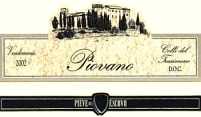
|
|
Colli del Trasimeno Piovano 2002 |
|
| Pieve del Vescovo (Italy) | |
| Grapes: Sangiovese (85%), Canaiolo, Gamay e Ciliegiolo (15%) | |
| Price: € 8,40 | Score: |
| This wine shows an intense ruby red color and nuances of ruby red, little transparency. The nose denotes intense, clean, pleasing, elegant and refined aromas that start with nuances of plum, blueberry and black cherry followed by intense aromas of raspberry, violet and licorice as well as pleasing hints of cinnamon, black pepper and eucalyptus. In the mouth has good correspondence to the nose, a slightly tannic attack however well balanced by alcohol, full body and intense flavors. The finish is persistent with intense flavors of plum, black cherry and blueberry. A well made wine. Piovano ages for 12 months in steel tanks and in bottle. | |
| Food Match: Roasted meat, Stewed and braised meat, Broiled meat and barbecue, Hard cheese | |
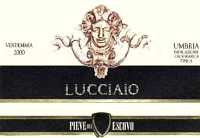
|
|
Lucciaio 2000 |
|
| Pieve del Vescovo (Italy) | |
| Grapes: Merlot (45%), Cabernet Sauvignon (40%), Sangiovese (15%) | |
| Price: € 19,00 | Score: |
| The wine shows an intense ruby red color and nuances of ruby red, little transparency. The nose reveals intense, clean, pleasing and elegant aromas which start with nuances of black cherry, blueberry and vanilla followed by pleasing aromas of plum, black currant, violet and licorice as well as good hints of cocoa and tobacco. In the mouth has good correspondence to the nose, a slightly tannic attack however well balanced by alcohol, good body and intense flavors. The finish is persistent with good flavors of plum, black cherry and blueberry. A well made wine. Lucciaio ages for 12 months in barrique followed by 12 months of aging in bottle. | |
| Food Match: Braised and stewed meat with mushrooms, Roasted meat, Game, Hard cheese | |
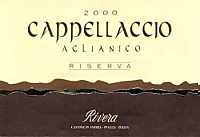
|
|
Castel del Monte Aglianico Riserva Cappellaccio 2000 |
|
| Rivera (Italy) | |
| Grapes: Aglianico | |
| Price: € 8,00 | Score: |
| The wine shows an intense ruby red color and nuances of ruby red, little transparency. The nose reveals intense, clean, pleasing and elegant aromas that start with hints of black cherry and plum followed by good aromas of carob, blueberry, violet and pleasing hints of vanilla and licorice. In the mouth has good correspondence to the nose, a slightly tannic attack however balanced, good body and intense flavors. The finish is persistent with flavors of black cherry, plum and blueberry. Cappellaccio ages for about 12 months in barrique. | |
| Food Match: Braised meat with mushrooms, Roasted meat, Hard cheese | |
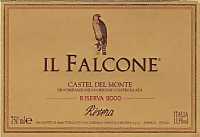
|
|
Castel del Monte Riserva Il Falcone 2000 |
|
| Rivera (Italy) | |
| Grapes: Nero di Troia (70%), Montepulciano (30%) | |
| Price: € 14,00 | Score: |
| This wine shows a deep ruby red color and nuances of ruby red, little transparency. The nose reveals intense, clean, pleasing, elegant and refined aromas which start with aromas of black cherry, blueberry and plum followed by good and intense aromas of carob, tobacco, violet, licorice, vanilla and pleasing hints of black pepper. In the mouth has good correspondence to the nose, a slightly tannic attack however well balanced by alcohol, full body, intense flavors. The finish is persistent with flavors of black cherry, blueberry and plum. A well made wine. Il Falcone ages for 12-14 months in barrique and for 1 year in bottle. | |
| Food Match: Game, Braised and stewed meat, Roasted meat, Hard cheese | |
Mario SchiopettoMario Schiopetto is one of those extraordinary persons who made Italian wine great in the world. His wines, result of true passion, are the genuine image of their territory: Collio |
|
Talking about Mario Schiopetto means, besides talking about the great wines of Collio, to tell the story of modern Italian enology. Thanks to great men, just like Mario Schiopetto who worked and believed in his ideas, Italian wine is now considered great again as a consequence of a formidable process of innovation and improvement of quality. Mario Schiopetto comes from a family which produces wines since three generations. Son of Giorgio, owner of the historical tavern “Ai Pompieri” in Udine, Mario Schiopetto received from his father the great passion for wine, fine wine, and he will later be considered as the real father of the Enology in Friuli Venezia Giulia. Mario Schiopetto travels in the main wine countries of Europe, in the historical wineries of France and Germany with the clear intent of learning the secrets of great quality wines: an experience that will be useful to realize his project, the one of making Friuli's wine great. During his journeys abroad he learns the modern and important techniques useful for the production of excellent and quality wine, however he knows this is not enough to make great wines.
The territory where Mario Schiopetto intends to realize his ambitious dream is in the Gorizia's Collio, one of the great wine areas in Friuli Venezia Giulia, and he understands from the beginning the technical notions he learnt abroad must be patiently adapted to the nature of his land, an unique and particular place. Mario Schiopetto is an autodidact with an excellent capacity of intuition and in 1965 he finally is successful in realizing his ambitions and rents an old winery in Gorizia from the bishop's see that he will later buy in 1989. In his winery he applies from the very beginning principles of simplicity, technology and sensibility for his territory while continuously improving his knowledge acquired during his journeys abroad. His indisputable and deep knowledge is passed to his sons Maria Angela, Carlo and Giorgio who run the winery successfully today, located in the hills of Capriva del Friuli, in the province of Gorizia. The winery currently have 30 hectares of vineyards (about 74 acres) located nearby the historical palace of the bishop's see, as well as Blumeri estate which is located not far from the wine area of Colli Orientali del Friuli, at Oleis, in the hills of Rosazzo. The production of the winery is based on a philosophy which supports the idea there is nothing to invent, but everything to be understood. According to Mario Schiopetto «Good wine is the most genuine expression of the territory as well as the expression of men which created it. In order to make good wine the respect for nature and men is the first and fundamental requisite». The sensibility, according to the winery's philosophy, «takes its origin from an ancient and uninterrupted dialog with nature. A unique treasure, a richness of the soul», a principle Mario Schiopetto always believed in even before establishing his famous winery in 1965 and that he understood when he was a kid and listened to the wine “gurgling” in the casks of his father's tavern. This principle subsequently developed in the 1950's by traveling all over Europe and visiting the best wineries. In France and in Germany Mario Schiopetto acquired an unique patrimony of experiences who then decided to donate to Friuli, his beloved land, by establishing his winery. That's how he started to put into practice what he learnt during his journeys by applying the concepts to the unique land of Gorizia's Collio, while believing of not having invented anything but just tried to understand his land, the climate and the character of his hills by simply observing the harmony of nature. On these simple principles is still based the activity of Mario Schiopetto's winery. By applying and using the great experience of the father Mario, not only founder of the winery but also father of the wine culture in Friuli, before him, his father Giorgio, very appreciated host in Udine in the beginning of 1900's, today are his sons who inherited the huge and precious heritage of the winery. Maria Angela, Carlo and Giorgio continue today the impressive job of their father which is based on ancient traditions and is always origin of stories to be told, made of sensibility and respect, of love for tradition and of that genuine passion for wine which always characterized Mario Schiopetto.
The winery is located in the hills of Capriva del Friuli and the new cellar was built by following the hints and the sensibility of architect Tobia Scarpa, therefore originating an union of technique, order and rationality. The new winery was personally designed by Mario Schiopetto and its construction started in 1989, giving the priority to a better management of work places, therefore trying to apply a logic of usability instead of aesthetics. The structure was designed in order to allow a practical course of the wine production phases, from grapes to the finished product. The new winery was completed in 1992 and its “heart” is represented by the yeasts room, a fundamental element of the winery's philosophy and of the productive process. Here it is done the multiplication of autochthonous yeasts, according to the many wine styles, needed for the fermentation process. Moreover other modern technologies have been adopted in order to reduce the possibilities of error and therefore to follow the ancient art of the production of excellent wines. The historical vineyards of Mario Schiopetto's winery are located at Capriva del Friuli, in the province of Gorizia, and here are cultivated the grapes Tocai, Pinot Blanc, Pinot Gris and Sauvignon Blanc in an ideal environment that allows them to give their best. In 1996 the winery bought Blumeri estate, which is located few kilometers north-west from the historical headquarter, in the fertile hills in Rosazzo, at Oleis. This place, with a magic and sweet name, has a particular historical tradition both to vine and olive. The new estate was chosen by Maria Angela, Giorgio and Carlo, sons of Mario Schiopetto, because the soil has a composition similar to the ones in Capriva del Friuli, of course the climate is different and however suited to favor the maturation of red grapes. Vineyards in Olesis have been restored and destined to the production of important wines and its name, Blumeri estate, derives from an ancient carnival tradition of Colli Orientali del Friuli. The selection of wines of Mario Schiopetto's winery is pretty vast and the production is made both with local and international grapes. Among typical grapes there is Tocai Friulano, the famous white berried grape of Friuli Venezia Giulia vinified alone for Tocai Friulano and Pardes wines, the latter fermented and aged in cask for about 10 months. Among mono varietal white wines there are Pinot Blanc, Pinot Gris and Sauvignon, all fermented and aged in steel tanks. Among other white wines, Mario Schiopetto produces Blanc des Rosis, “historical” wine from Tocai Friulano, Pinot Gris, Sauvignon Blanc, Malvasia and Ribolla grapes; Mario Schiopetto Bianco, produced with Chardonnay and Tocai Friulano of which a part ferments in cask; Amrità Pinot Blanc, produced with the homonymous grape, fermented and aged for about 10 months in cask; Tarsia Sauvignon, fermented and aged in cask for about 10 months. Among red wines there are Rivarossa, produced with Cabernet Sauvignon, Cabernet Franc and Merlot grapes, aged for 14-15 months in barrique; and Blumeri Rosso, produced with Merlot, Cabernet Sauvignon and Refosco dal Peduncolo Rosso grapes, aged for 14-15 months in barrique.
|
||||||||||||||||||||
|
Score legend Prices are to be considered as indicative. Prices may vary according to the country or the shop where wines are bought |
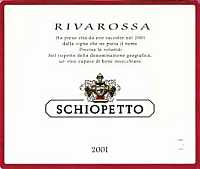
|
|
Rivarossa 2001 |
|
| Schiopetto (Italy) | |
| Grapes: Cabernet Sauvignon (35%), Cabernet Franc (35%), Merlot (30%) | |
| Price: € 16,00 | Score: |
| The wine shows a brilliant ruby red color and nuances of ruby red, moderate transparency. The nose denotes intense, clean, pleasing and elegant aromas which open up with aromas of fruits such as black cherry, blackberry, blueberry, raspberry, black currant and plum followed by pleasing hints of vanilla and carob. In the mouth has good correspondence to the nose, a slightly tannic attack however well balanced by alcohol, intense flavors and good body. The finish is persistent with good flavors of black cherry, plum and blueberry . Rivarossa ages in barrique for about 14-15 months. | |
| Food Match: Braised meat with mushrooms, Roasted meat, Hard cheese | |

|
|
Collio Tocai Friulano 2002 |
|
| Schiopetto (Italy) | |
| Grapes: Tocai Friulano | |
| Price: € 16,00 | Score: |
| This wine shows a brilliant straw yellow color and nuances of straw yellow, very transparent. The nose denotes intense, clean, elegant and pleasing aromas of apple, pear, peach, almond and hawthorn followed by pleasing hints of broom and elder. In the mouth has good correspondence to the nose, a crisp and pleasing attack however well balanced, good body and intense flavors. The finish is persistent with pleasing flavors of almond, peach and pear. This Tocai Friulano ferments in steel tanks and ages for 7-8 months on lees. | |
| Food Match: Roasted fish, Crustaceans, Paste and risotto with fish, Sauteed white meat | |
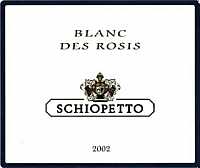
|
|
Blanc des Rosis 2002 |
|
| Schiopetto (Italy) | |
| Grapes: Tocai Friulano (40%), Pinot Grigio (20%), Sauvignon Blanc (15%), Malvasia Istriana (15%), Ribolla Gialla (10%) | |
| Price: € 16,00 | Score: |
| The wine shoes a beautiful and brilliant straw yellow color and nuances of straw yellow, very transparent. The nose reveals intense, clean, elegant and refined aromas which open up with fruits such as pear, peach, apple and lemon followed by pleasing aromas of hawthorn, broom, almond and hazelnut. In the mouth has good correspondence to the nose, a pleasing crisp attack however well balanced, good body and intense flavors. The finish is persistent with good and clean flavors of peach, pear and almond. Blanc des Rosis ferments in steel tanks and 5% of Malvasia Istriana ferments in cask. | |
| Food Match: Roasted fish, Crustaceans, Pasta and risotto with fish, Soft cheese | |
| Azienda Agricola Mario Schiopetto - Via Palazzo Arcivescovile, 1 - 34070 Capriva del Friuli (Gorizia) Tel. 0481 80332 Fax 0481 808073 - Winemaker: Giorgio Schiopetto e Stefano Menotti - Established: 1965 - Production: 210.000 bottles - E-Mail: azienda@schiopetto.it - WEB: www.schiopetto.it |
Cellar Journal |
|
This section is reserved to wine producers who want to publish news and information about their business, to announce new products or just for communicating to its customers information and promotions about their products and activity. Send news to be published at our e-mail address.
|
EnoGlass: the New DiWineTaste's GameAfter EnoQuiz, DiWineTaste's quiz about wine, now it is available on our site EnoGlass, the new game about wine and glasses |
|
This month in our WEB site you will notice something different: in the navigation menu, in the position occupied by EnoQuiz, you will find a more generic item “EnoGames”. Don't worry, we did not remove or eliminate EnoQuiz, we just put it on a more specific section expressly dedicated to the amusing aspect of wine, therefore giving our readers the possibility of learning new things while testing their knowledge and having fun. The first experiment in this sense has been EnoQuiz, a quiz about wine culture, which has been very appreciated since the very beginning of its debut and hundreds of visitors use it daily to test their knowledge. The project of developing interactive tools about wine was, and still is, one of the services we want to offer our web site's visitors; the Wines Guide and EnoQuiz are just our first two steps. For this reason, in the aim of evolving our services, today we are offering you a new game to test your knowledge about an important aspect of wine service: choosing the right glass for a specific wine. EnoGlass is the new interactive quiz available on our WEB site and that can be found in the new page EnoGames. EnoGlass will show 10 wines, selected among the ones included in our wines guide: next to them are shown some glasses and you will be asked to choose the appropriate one. Wines used for EnoGlass are all present in the Wines Guide therefore allowing a further study in case it would be necessary to know more about the wines shown by the quiz. Wines shown by the quiz are to be considered as “ready”, that is are to be considered in the age and in the state at the moment the relative producers release them on the market. For this reason EnoGlass never indicates next to wines the year of vintage.
After having answered all questions of the quiz, EnoGlass will display the score according to the answers provided. Every question answered right will score one point, whereas zero point will be scored for every wrong answer. The highest score in EnoGlass is 10. The purpose of EnoGlass is to improve the knowledge about wine service and to understand the importance of glasses, as well as favoring a better knowledge of the many wines and their grapes. A glass is also chosen according to the organoleptic characteristics of the grapes used to make a wine as well as the aging time, wine making techniques and, sometimes, the area of origin. We wish EnoGlass will be of interest for our readers just like EnoQuiz and, as always, your comments and your suggestions are welcome: they are for us an essential and fundamental help that allow us to improve the quality of our publication, of our site and of the services we are offering to our readers. Enjoy EnoGlass!
|
||||||||
News |
|
In this section will be published news and information about events concerning the world of wine and food. Whoever is interested in publishing this kind of information can send us a mail at our address.
|
Matching Food with Fortified WinesFortified wines are usually considered as products to be drunk alone, however they offer interesting and unsuspicious qualities in the matching with food as well |
|
Fortified wines are produced by adding some alcohol, or wine spirit, in the fermenting must or in the finished products and this practice is known as fortification. These important wines, which had a glorious past and were considered as precious commercial products in the past centuries, are often forgotten and not very considered in the enological scene, maybe because consumers do not understand their own identity, confused by the idea of whether they should be considered as wines or liquors. Perhaps the adding of alcohol is what makes these wines not to be accepted as real wines and for this reason some may have prejudices on their identity, however fortification is a process which contributes in these wines to their stabilization and preservation as well as contributing to their balance. Tasting fortified wines is however a pretty complex practice, as well as interesting, for the sensorial and organoleptic evaluation. In the past centuries fortified wines were highly valued and appreciated by the noble classes of the European countries, in particular the one of England, which imported huge quantities of Port, Madeira and Jerez, known in England as Sherry, and later huge quantities of Marsala as well. The consumption of these wines was pretty common and they were often included in the official and indispensable beverages for ship's crews: it seems that even today it is still common the tradition of the English Royal Navy to drink the renowned Marsala. In the past centuries fortified wines were usually drunk alone, at the end of the meal or during the talks of gentlemen, and they were even created real and proper ceremonies for the opening of the bottles and the way the content would have been poured on the glass, as it was for Port wine in England. The bottle, as it was opened, sometimes by means of incandescent pliers in order to snap the bottle's neck and without removing the fragile cork damaged by time, was passed from one participant to another by making it slide on the table and without raising it, in order not to make the wine turbid because of the sediments developed in the course of tens of years of aging.
Even today fortified wines are usually consumed alone, often served as aperitifs, and in particular offered at the end of a meal instead of a brandy or a liquor. These wines are also considered as meditation wines, that is wines to be slowly sipped while contemplating the finesse and the quality of the product during tranquil and calm moments. Maybe the quantity of alcohol they contain, usually between 14% and 20%, make them not to be considered in the matching with food because they are wines to be consumed, rightly, in small quantities. The high alcohol by volume does not allow the kind of relationship one may have with another “normal” wine: the glass in which they are generally served is small and suggest a limited and moderated consumption. It should however be observed that in these wines the intensity of aromas and flavors is strong and their taste-olfactory persistence is pleasingly long, therefore a smaller quantity is enough to allow their appreciation, in particular with certain foods having organoleptic characteristics that would cover the ones of many “regular” wines.
|
||||||||
|
Among fortified wines the ones from Spain, Portugal, Italy and France are the most renowned ones. Despite the fact it is less frequent, fortified wines are also produced in Australia, South Africa and in other countries of the world, however the typical ones from the historical wine countries of the world play a fundamental role in their category. Spain produces two excellent fortified wines renowned everywhere: Jerez, also known as Sherry or Xérès, and Málaga. Jerez is an extraordinary fortified wine and thanks to its many styles can offer wide and interesting possibilities in the matching with food. The production of Jerez consists in an enchanting process from which are made many styles of wine. The grapes typically used for its production are Palomino, mainly used for dry Jerez, Pedro Ximenéz and Muscatel for sweet or semi-sweet Jerez. The production begins with the vinification of the must and at the end of this process the wine is evaluated in order to decide its best “future”, that is whether the wine should evolve as Fino or Oloroso, the two families of Jerez. The difference between fino and oloroso consists in the way they will age and refine with time. Base wines used for the production of Jerez age in casks not completely filled, they are usually filled for four fifths, and they are fortified, that is a quantity of alcohol is added, up to having 15% of alcohol by volume for Jerez Fino and 18% for Jerez Oloroso. Thanks to the lower alcohol by volume, in Jerez Fino will develop a precious and essential layer of microorganisms, yeasts of the saccharomyces species, that will completely cover the surface of the wine in the cask, an event which does not take place in Jerez Oloroso because of the higher quantity of alcohol. This layer of yeasts, called flor, shields the wine from oxygen, therefore preventing its oxidization, and its activity will alter the organoleptic qualities of the wine while giving it a complex and unique character. In Oloroso, in which the flor does not develop, an oxidization takes place instead and this will alter its organoleptic qualities, very different from the ones that will develop in fino, and the effects of this event are also evident in the color. Jerez Fino has a straw yellow color, common in white wines, whereas Jerez Oloroso have an intense amber color: from the same base wine and thanks to the events which take place, are obtained two very different products but however both interesting and complex. The aging of Jerez is done with a particular system called Solera y Criaderas (figure ), also used for the aging of other fortified wines, such as Marsala. The system consists in stacking rows of casks one upon another, each row is called escala and contains a wines of a particular average age, the lowest row which is contact to the floor is called solera and contains the oldest wine. The row stacked upon solera is called 1st criadera, the next one is called 2nd criadera and so on until the highest row which is called last criadera. The system consists in drawing a quantity of wine off from the solera, usually not more that one third of the cask's capacity, and this wine will be bottled: this operation is called saca and it is usually done two or three times per year. The part drawn off from solera is replaced by the wine contained in the higher row, the 1st criadera, which is subsequently filled with the wine of the 2nd criadera, the process is repeated until the last criadera which is filled with new young wine. These operations of filling are called rocio. The Solera y Criaderas system ensures a constant quality of the wine and it is based on the principle that a young wine acquires the character of the older when properly blended. In Jerez wines produced with this method, as well as in other fortified wines, next to the term solera can be found the year, usually very old, and this does not have any connection with the vintage of the wine contained in the bottle, it simply indicates the year when the Solera y Criaderas system was started. Therefore in case a bottle reads “Solera 1870”, it means the wine was drawn off from a solera started in 1870 and of which, of course, cannot be determined the exact vintage because the system includes wines blended from that year on. Among Jerez “Fino” styles there is Manzanilla, produced at Sanlúcar de Barrameda, very typical for its very dry taste. Among other Jerez styles should be remembered Amontillado, a Jerez Fino aged for long time after the flor disappeared; Medium, a sweeter amontillado; Palo Cortado, Oloroso and Cream, sweeter than the first twos; Pedro Ximenéz, sweet and dense, produced with the homonymous grape dried under the sun; and finally Pale Cream, a sweet Jerez Fino. Jerez wines are usually dry, however are pretty renowned the sweet styles produced with the adding of wines made of Pedro Ximenéz and Muscatel grapes. East from Jerez is produced another famous fortified wine of Spain: Málaga. Produced in the homonymous city, this wine usually makes use of the same techniques for Jerez and the grapes that make it are Pedro Ximenéz, Muscatel and Airèn. Málaga is produced both dry and sweet, where sweetness is obtained by adding cooked must. Portugal produces two famous fortified wines: Port and Madeira. The production of Port consists in interrupting the fermentation process of the must by adding alcohol. There are two styles of Port: white, exclusively produced with white berried grapes including Malvasia and Verdelho, and red, produced with red berried grapes, including Tinta Roriz, Touriga Francesa and Touriga Nacional. White Port is a delicate and aromatic wine produced both as dry and sweet. Among the most simple red Port styles there are Ruby, a young wine with evident aromas of fresh fruits, and Tawny, usually aged in cask for about 3 years and having a color with nuances of orange because of oxidization. Ports of superior quality are characterized by pretty long aging periods. Reserve is a Port with an average aging time of 7 years, however aging can also be longer: quality Tawny Ports can also be aged for 40 years and more. Among the most looked for Ports should be mentioned Vintages, wines of a specific vintage and expressly created to give their best after a patient and long aging in bottle, usually tens of years. Of particular interest are also Late Bottled Vintage Ports (LBV), usually aged in cask for about 5 years, and Crusted Ports, produced by blending different vintages and subsequently aged in cask for about 4 years. The island of Madeira is famous for the excellent and homonymous fortified wine which differs from the others because of the production method. This wine takes its excellent quality from the estufagem method, a process consisting in heating the wine for at least 90 days, as well as from the effects of oxidization. In France the so called Vin Doux Naturel are produced by fortifying the fermenting must in order to interrupt the process and to keep sugar. Renowned are Vin Doux Naturel from Languedoc-Roussillon produced with Muscat Blanc, such as Muscat de Frontignan and Muscat de Rivesaltes, as well as Banyuls, a red fortified wine mainly produced with Grenache Noir grape in the area of Pyrenees, available both as dry and sweet.
In Italy the most representative fortified wine is the famous Marsala. The production of wines in Marsala is dated back to very ancient times, however its notoriety increased at the end of 1700's when an English merchant, John Woodhouse, was surprised by this wine and decided to export it to his homeland. In order to better preserve the wine to the risks of a long journey in the hold of a ship, he decided to add some alcohol, probably remembering the common practice used for Spanish and Portuguese fortified wines, very renowned and appreciated in England. The success was so striking that Woodhouse decided to produce Marsala himself and to export it to the United Kingdom. After this initial success, other producers began the production of Marsala and in the course of time they all contributed to improve this great wine and that would certainly deserve a higher consideration. Marsala is a white fortified wine produced with Grillo, Inzolia, Catarratto and Damaschino grapes, however there is also a red style produced with Pignatello, Nero d'Avola and Nerello Mascalese grapes. The production of Marsala consists in fortifying a base wine, white or red, to which is added, according to the style, concentrated must, muted must, that is must to which is added alcohol in order not to start fermentation, or cooked must. Marsala wines are classified according the following categories: Marsala Ambra, Marsala Oro and Marsala Rubino. Marsala Ambra is produced by adding cooked must to a base wine, Marsala Oro is exclusively produced with white berried grapes and the adding of cooked must is not allowed, whereas Marsala Rubino is produced with red berried grapes and the adding of cooked must is not allowed. The fortification of Marsala Oro and Rubino is done by adding brandy aged for 5 years in cask instead of alcohol. Marsala wines are classified as: Marsala Fine, with an aging time of at least one year; Marsala Superiore, aged for at least two years; Marsala Superiore Riserva, aged for at least four years; Marsala Vergine and/or Soleras, aged at least five years; Marsala Vergine Stravecchio or Riserva, aged for at least ten years. Marsala Vergine is exclusively obtained by fortifying the base wine with alcohol or brandy and the adding of the components allowed in other styles, such as cooked or concentrated must, is forbidden. Marsala is sometimes aged with the Solera y Criaderas method (figure ). Finally, Marsala is produced as dry, demisec or sweet, according to the quantity of cooked or concentrated must added to the base wine. By considering the production method of Marsala Vergine, the most elegant and refined among Marsala wines, the only style that can be produced is dry.
|
||||||||||||
|
Fortified wines are generally tasted alone and without any food matching, however these extraordinary wines are very versatile and suited for food matching. Before discussing the characteristics useful for the matching with food, it is appropriate to consider the way these wines should be served. The glass generally used has a small size in order to favor the service of little quantities. The producers of many fortified wines have proposed different shapes and sizes for their wines, such as for Jerez, traditionally served in copita, a glass resembling the shape of an ISO tasting glass, a choice which certainly exalts the aromatic finesse and richness of these wines. In case copitas or small glasses are not available, the best choice certainly is the ISO tasting glass. Temperature in fortified wines is, just like for sweet and botrytized wines, pretty wide, generally between 10° and 18° C (50-65° F), however there are many who support the idea these wines should be served chilled, even at 6° C (42° F). The considerations on temperature are always the same: high temperatures accentuate alcohol, sweetness and aromas, low temperatures attenuate them while accentuating astringency. An alcoholic and sweet fortified wine can be served at a lower temperature, while paying attention to not penalizing aromas too much. The matching of food with fortified wines must consider, first of all, the qualities of the wine. Fortified wines have an alcohol by volume usually between 15% and 22%, therefore their contrasting action on succulence and the capacity of cleansing unctuous foods will be pretty evident. Alcohol also attenuates the relative perception of sweetness, therefore a sweet fortified wine will appear as less sweet of what it is for real, and the two components together contribute to the overall roundness of the wine. Even acidity will be carefully evaluated: despite alcohol will play an important role in the balance by lowering the relative perception of acidity, this sensation is however a characteristic in white wines. Finally astringency, particularly in red fortified wines, augmented by the effects of the aging in cask, is a characteristic frequently found in white fortified wines as well. Sweet fortified wines are excellent companion for desserts and confectionery, in particular for elaborated cakes enriched with complex ingredients, such as dried fruits and fruit jams. Thanks to the appreciable roundness and sweetness, together with alcohol and acidity, these wines are magnificent companions for hard cheese, in particular with piquant cheese, such as Gorgonzola or Roquefort, renowned is the matching of Marsala Superiore Riserva with Gorgonzola, as well as Port with Stilton. Fortified wines are usually destined with the matching of desserts and cheese, indeed, in case their organoleptic characteristics are carefully evaluated, particularly sweetness, they can also be used for interesting and extraordinary matchings with other and unsuspicious foods. This hypothesis is confirmed by the long Spanish tradition of matching dry Jerez with the tasty “tapas”, the renowned culinary preparations offered with aperitifs or used as appetizers. Dry fortified wines can be well matched with many recipes based on meat and fish, but also with pasta and rice, as well as game. In this specific case it is good to choose dry and demisec fortified wines with an adequate alcohol by volume, very wide in these wines, usually ranging from 15% to 22%. An example is offered by Jerez Fino or Manzanilla, usually less alcoholic, very versatile in the matching with food, perfect with fish, in particular with crustaceans as well as with cold cuts. Rich Jerez Oloroso or Palo Cortado are, for example, well matchable with meat and game. The same considerations are also valid for dry Marsala and Marsala Vergine. Sweet fortified wines are good companions of desserts and cheese, hard or piquant, and in case the alcohol by volume is sufficiently high, between 18%-22%, they can be matched with chocolate, a complex food notoriously considered as scarcely matchable with wine. As an example it can be tried a Jerez Pedro Ximenéz, a Port or a Marsala Superiore Dolce matched with chocolate as well as with a cake made of chocolate.
|
Mozzarella CheeseA traditional cheese of southern Italy, it is classified as a spun paste cheese having soft consistency. It is one of the most famous cheeses, it is an ingredient of many culinary preparations and in particular pizza |
|
The term “mozzarella” derives by the Italian verb “mozzare” (literally “to cut off”) and describes the operation, still done today, of cutting with the hands the spun paste with the thumb and the forefinger, called “mozzatura”.
|
|
Mozzarella has a very ancient history and an uncertain origin. The history of this cheese is directly connected to the introduction of the buffalo in Campania, a region of south Italy, and some believe it was in the sixth century, whereas others say it was introduced in Italy by Hannibal. Talking about evidences of the past, there are some information provided by a historian of the “Chiesa Metropolitana di Capua”, Monsignor Alicandri. In one of his writings it is read that near the Monastery of Saint Lorenzo in Capua - it was twelfth century - monks offered to pilgrims a piece of bread and a mozza or provatura. The writing literally reads: “…one mozza or provatura with a little piece of bread was offered by monks of monastery of Saint Lorenzo in Capua as agnitionem dominii to the metropolitan church to which every year, because of an ancient tradition in occasion of the fourth fair of legations, a procession used to go to that Church…”. The term “mozzarella” is directly connected to the locution “mozza”, a term used to refer to provatura, that is provola, another typical cheese of Campania, as it was clearly written by Monsignor Alicandri. Investigating on the contract works about the product of “Royal Industry of Pagliara delle bufale”, mozzarella had to stay in the sauce for 24 hours, whereas 48 hours was the time for provola. It is more and more evident that mozzarella was a byproduct of the preparation of provola, of course not a lower quality byproduct, but because of its evident difficulty in keeping freshness during the transportation, an indispensable condition for mozzarella. On the other hand provola was smoked in order to preserve it longer. Therefore mozzarella was a product mainly used in the families of producers or destined to the most refined gourmets. The term “mozzarella” is also found in the sixteenth century, precisely in 1570, cited in a cookbook written by Bartolomeo Scappi, cook of the papal court where specialties from every part of Europe were always present. The book reads “…milk cream, fresh butter, ricotta cheese, fresh mozzarella and milk…”. Even though mozzarella and other cheeses were mentioned from 1500 on, it does not seem these products were common, in fact, according to some documents of that time, only smoked and soft provola are mentioned. The spreading of mozzarella was later and as a consequence of a fundamental event. Thanks to a farm where buffaloes were bred and their milk was processed, Tenuta Reale, also known as “Reggia di Carditello”, mozzarella cheese began to acquire notoriety and to spread. It started to be present in markets around 1720 and it will become widely known from 1780 on. After the Union of Italy, in Aversa, Campania, a market for mozzarella and other cheeses was established in the purpose of regulating the marketing of such products. Mozzarella cheese has always been connected to buffalo, although in the beginning it was used for many works, and it later became precious because of its milk. From 1600 on can be found evidences about “bufalare”: buildings having a round shape where buffalo milk was processed in order to make cheeses such as caciocavallo, butter, ricotta and, of course, mozzarella. In the beginning mozzarella, because of its perishability, was mainly destined to the local consumption.
|
||||
|
Technically speaking the term mozzarella is used to refer to a soft cheese, with soft paste, raw and spun, made of layers and a very thin crust. Today it is produced in many shapes and sizes. The first stage of the production of mozzarella concerns milk, filtered in order to eliminate any impurity and pasteurized in order to eliminate any pathogen bacteria, therefore it is coagulated by means of calf's rennet. In the next stage the compound is heated to the optimal temperature of 34-38° C (93-100° F). In past times it was added boiling milk whereas today the milk is heated by using steam. The time required for milk to coagulate is of about thirty minutes and sometimes it can also take one hour. The mass composing the curd is then broken in pretty large pieces and allowed to rest. The next operation consists in breaking the curd by means of a pole to whose end is placed a disc of wood or by using a metallic tool, until obtaining fragments of 3-6 centimeters in size (1-2.5 inches). This operation, apparently simple, is done with extreme care and attention by specialized personnel, even because during the breaking of curd some fat is generally lost (about 1%) in the whey.
After the curd has been broken it is allowed to acidify in the whey. This stage of the process is fundamental for the quality of the final product and the duration of acidification represents a factor extremely important for the characteristics of mozzarella. At this point, the curd is laid on a table to drain and to age for about 20-30 minutes. In south Italy mozzarella is usually preferred with a more evident acidulous taste, more suited for winter time. The right level of aging of mozzarella is determined as follows: 100 grams of aged paste is being melted in hot water and then by means of a stick it is tested its capacity to spin. In case the paste can stretch in strings of about one meter and without breaking, the mozzarella is considered to be “ready”. This operation, apparently simple, requires the experience and skill of a competent dairyman in order to successfully pass this critical stage of production. An underripe or overripe curd will produce a mozzarella with low consistency and a lowering of the production yields. The remaining whey from the production, rich in proteins, will be used for the production of ricotta cheese. The next stage is called “spinning” and it is the stage which greatly affects the consistency of mozzarella. In the traditional production this operation is still done by hand and consists in cutting the curd in thin slices, put in a wooden tank and, by adding hot water at 80° C (176° F), it is melted. By using traditional tools, a bowl and a pole, the curd is mixed and kneaded until obtaining a homogeneous paste with a lucid aspect, while allowing the draining of the exceeding whey. Because of this kind of process mozzarella cheese is classified as a “spun” paste cheese. Then it follows the procedure of “shaping”, that is the operation that will determine the portions of the paste. Two people are needed in order to manipulate, with mastery and expert movements, as well as for “mozzare” (cutting off) the paste by squeezing it between the thumb and the forefinger, in order to make pieces of the desired size that are subsequently submerged in cold water. In this phase are also produced the many mozzarella shapes, including the characteristic plait shaped, produced by plaiting three segments of paste. In artisan dairies this phase is still done by hand, in industrial dairies the operation is done by machineries. The last stage of the production consists in salting the mozzarella by submerging it in a salted solution of 10-18%. The duration of the operation varies from dairy to dairy and depends on the concentration of salt in the solution as well as the size. Salting can also be done during the process of spinning. During this stage, salt penetrates in the surface of mozzarella and therefore it spread on the inside during the stay of mozzarella in its preserving liquid. This liquid is used to preserve mozzarella until consumption and it is traditionally made of water used for spinning, salt and diluted whey, however it can also be replaced by salted water and citric or lactic acid. The latter liquid is believed to be better because allows mozzarella to be preserved for a longer time.
|
||||||||
|
The period of preservation of mozzarella depends on the quality of the ingredients and of the production. It is generally kept submerged in the preserving liquid for 3 or 4 days at a temperature of about 10-15° C (50-60° F) without losing its characteristics. After this period the product begins losing consistency, the external part begins to deteriorate, loses its characteristic structure and its consistency becomes more “buttery”. in this case it is preferred to consume it cooked. In case it is kept in the refrigerator, in order to best appreciate its characteristics it is advised to keep it at room temperature for at least 30 minutes, then it should be submerged for five minutes in warm water at a temperature of 35-40° C (95-105° F), anyway, being a fresh product it is always best to use it the least possible time. On the other hand, in case it is used for cooking, it is a good practice to remove it from its preserving liquid and to keep it in the refrigerator for some hours in order to allow the exceeding liquid to drain and to increase consistency.
|
|
The main differences depend on the milk used for the production of mozzarella. The main difference between buffalo milk and cow milk is about the contents in fats and proteins, fundamental characteristics for the dairy industry. Usually buffalo milk contains a higher concentration of some lacto-bacteria, responsible for the differences in taste and aroma and, it seems, they also influence the acidification of curd. “Fior di latte” (literally “flower of milk”) is a modern term, in the Neapolitan language does not exist the distinction “mozzarella fior di latte” but only the generic term mozzarella, without any distinction. The term “fior di latte” seems to have originated in Tuscany. According to laws for the safeguarding of this cheese, mozzarella is classified as follows:
|
Wine Parade |
|
|
| The best 15 wines according to DiWineTaste's readers. To express your best three wines send us an E-mail or fill in the form available at our WEB site. |
| Rank | Wine, Producer | |
|---|---|---|
| 1 |
| Franciacorta Cuvée Annamaria Clementi 1996, Ca' del Bosco (Italy) |
| 2 |
| Colli Bolognesi Pignoletto Superiore “Prova d'Autore” 2001, Bonfiglio (Italy) |
| 3 |
| Fumé Blanc Napa Valley 2001, Grgich Hills (USA) |
| 4 |
| Masseto 1998, Tenuta dell'Ornellaia (Italy) |
| 5 |
| Alto Adige Gewürztraminer Kolbenhof 2002, Hofstätter (Italy) |
| 6 |
| Château Laroque Saint-Émilion Grand Cru Classè 1998 (France) |
| 7 |
| Teroldego Rotaliano Granato 1998, Foradori (Italy) |
| 8 |
| Capo di Stato 1998, Conte Loredan Gasparin (Italy) |
| 9 |
| Margaux 2000, Ségla (France) |
| 10 |
| Sauvignon Blanc 2000, Cakebread (USA) |
| 11 |
| Barolo Brunate 1999, Enzo Boglietti (Italy) |
| 12 |
| Shiraz 2000, Plantaganet (Australia) |
| 13 |
| Turriga 1998, Argiolas (Italy) |
| 14 |
| Syrah Winemaker's Lot Vic 3, Concha y Toro (Chile) |
| 15 |
| Sauvignon Blanc Reserve Marlborough 2002, Kaituna Hills (New Zealand) |
| |||||||
Privacy Policy | |||||||


| Copyright © 2002-2024 Antonello Biancalana, DiWineTaste - All rights reserved |
| All rights reserved under international copyright conventions. No part of this publication and of this WEB site may be
reproduced or utilized in any form or by any means, electronic or mechanical, without permission in writing from DiWineTaste. |